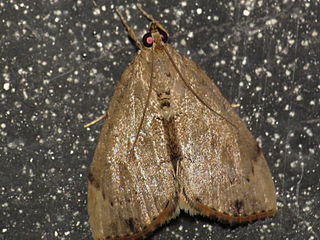
The Pyralidae, commonly called pyralid moths, snout moths or grass moths, are a family of Lepidoptera in the ditrysian superfamily Pyraloidea. In many classifications, the grass moths (Crambidae) are included in the Pyralidae as a subfamily, making the combined group one of the largest families in the Lepidoptera. The latest review by Eugene G. Munroe and Maria Alma Solis retain the Crambidae as a full family of Pyraloidea.

The Pyraloidea are a moth superfamily containing about 16,000 described species worldwide, and probably at least as many more remain to be described. They are generally fairly small moths, and as such, they have been traditionally associated with the paraphyletic Microlepidoptera.

Metoeca is a genus of moths of the family Crambidae. It contains only one species Metoeca foedalis, which has a wide distribution, including the Democratic Republic of Congo, Equatorial Guinea, South Africa, China, Japan, Taiwan, Thailand, Myanmar and Australia (Queensland).

Doloessa viridis is a species of snout moth in the genus Doloessa. It was described by Philipp Christoph Zeller in 1848 and is known from Indonesia, Malaysia, Sri Lanka, China, Australia (Queensland), Taiwan, the Philippines and the Solomons.
Orthaga seminivea is a species of snout moth in the genus Orthaga. It is found in Australia.

Elophila responsalis is a moth in the family Crambidae. It was described by Francis Walker in 1866. It is found in Australia, where it has been recorded from Queensland.
Nymphicula christinae is a moth in the family Crambidae. It was described by David John Lawrence Agassiz in 2014. It is found in Australia, where it has been recorded from Queensland.

Strepsinoma foveata is a moth in the family Crambidae. It was described by Turner in 1937. It is found in Australia, where it has been recorded from New South Wales, Queensland and the Australian Capital Territory.
Ubida holomochla is a moth in the family Crambidae. It was described by Turner in 1904. It is found in Australia, where it has been recorded from Queensland and the Northern Territory.

Crocidolomia suffusalis, the croci, is a moth in the family Crambidae. It was described by George Hampson in 1891. It is found in south-east Asia, where it has been recorded from India, Sri Lanka, China, Thailand, Malaysia, Java, Bali, Borneo, the Philippines and Taiwan. It is also present in New Guinea and Australia, where it has been recorded from Queensland and New South Wales.
Perimeceta incrustalis is a moth in the family Crambidae. It was described by Snellen in 1895. It is found on Java and in Australia, where it has been recorded from northern Queensland.
Achyra nigrirenalis is a moth in the family Crambidae. It was described by George Hampson in 1913. It is found in Australia, where it has been recorded from Western Australia, the Northern Territory, Queensland and South Australia.
Uresiphita insulicola is a moth in the family Crambidae. It is found in Australia, where it has been recorded from Lord Howe Island, Norfolk Island and Queensland.

Nistra is a genus of snout moths in the family Crambidae. It is monotypic, being represented by the single species Nistra coelatalis, which was formerly included in the genus Agrotera.
Archernis leucocosma is a moth in the family Crambidae. It was described by Turner in 1908. It is found in Australia, where it has been recorded Queensland.
Palpita rhodocosta is a moth in the family Crambidae. It was described by Hiroshi Inoue in 1997. It is found in Papua New Guinea and Australia, where it has been recorded from Queensland.
Palpita hyaloptila is a moth in the family Crambidae. It was described by Turner in 1915. It is found in Australia, where it has been recorded from Queensland.
Palpita limbata is a moth in the family Crambidae. It is found on Rennell Island and Guadalcanal, as well as in Australia, where it has been recorded from Queensland and New South Wales.

Patania symphonodes is a species of moth in the family Crambidae. It was described by Turner in 1913. It is found in Australia, where it has been recorded from Queensland.
Syllepte phricosticha is a moth in the family Crambidae. It was described by Turner in 1908. It is found in Australia, where it has been recorded from Queensland.








